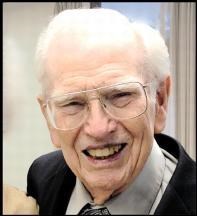Wayne Quinton
Wayne Quinton was an inventor and developed more than 40 biomedical devices. He was one of the pioneers of the bioengineering field. Many of his revolutionary devices are still in use in the medical field today.
His small and lightweight treadmill is the prototype of those used in fitness centers. He originally designed it for cardiac stress testing. He also designed the Quinton catheter. He is well-known for his work with kidney dialysis and worked with University of Washington doctors to develop the surgically implanted device that allows patients with kidney failure to receive regular dialysis.
He was born on January 4, 1921, and raised in Rigby, Idaho. “When he was a little boy, he spent weeks deconstructing and reassembling the metal toys he got for Christmas. He worked over one wind-up Model T car so often it got metal fatigue. So he taught himself how to solder, then repaired it. When he was in high school, his father suffered a heart attack and was ordered to years of bed rest—an event that not only fired Quinton's lifelong interest in medicine but elevated his mechanical work from a hobby to a practical necessity. He fashioned a mini-plow for the family Buick so he could navigate Idaho's wintertime roads as he drove his mother every morning to the dry-cleaning plant she owned. Soon, he could press pants with the best of them and repair any piece of equipment on the plant floor.”[1]
He studied physics and advanced math at Ricks College and Montana State University. In 1941, Boeing recruited him for work on the B-29 bomber as a master-layout draftsman. “He absorbed more valuable on-the-job tutoring from physicists and theoretical mathematicians while working as a draftsman on the aerospace company's first guided missile.”[2]
Seven years later he started work at the University of Washington, first as an electronics technician, and two years later, he became the foreman of the university’s medical school instrument shop. His job was to build anything that the physicians couldn’t buy. For example, when a gastroenterologist friend came to Quinton and said that “there was 20 feet of ileum in the small intestine that could not be biopsied without surgery. Brother Quinton then worked with him to develop a hydraulic gastrointestinal biopsy instrument that could be threaded down the stomach and into the ileum, allowing doctors to take several biopsies without any deterioration of the specimen.”[3]
In 1950, he was selected by Life magazine as one of the nation's "25 Top Young Scientists.”[4]
Quinton obtained his mechanical engineering degree in 1959 from the University of Washington. He took a wide array of classes, which enabled him to “do something many engineers couldn’t—speak physician.”[5] He effectively married the field of medicine with the field of engineering.[6]
He then left the university and founded Quinton Instruments where he manufactured many of his medical devices that the University of Washington declined to manufacture. He sold the company in 1984 for $55 million[7] and retired in 1991. However, he continued inventing in his home that included a design office and two underground shops.[8]
In 2009, the University of Washington awarded him the Alumnus Summa Laude Dignatus, “alumnus worthy of the highest praise”—the highest honor for its graduates.
Quinton joined The Church of Jesus Christ of Latter-day Saints at the age of 35.
He died of congestive heart failure at his home on January 22, 2015.
